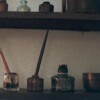Professional art historians are among the luckiest of God’s children. Our vocations consist in the study and praise of beautiful things. If we are fortunate to have an academic job, we can use the summer months to travel and discover even more beauty – and count this useful, as well!
So it was that I found myself at the small Santuario de Chimayo in rural New Mexico recently, absorbing an earthy, strident sort of beauty: adobe walls crouching in the shadows of sage-covered hills, gray wood creaking in a dry wind, coral-colored rocks crushed underfoot, a low doorway, then a cavelike quietness.
Many of us have heard of Lourdes, with its healing spring, or Compostela, or Guadalupe – exotic names, perhaps, and distant. The Santuario de Chimayo is like these: a place of miracle healings and mysterious events, thick with what Walter Benjamin dubbed “cult value” – the patina of life and suffering. Rosaries hang on fence posts, and photos of the sick or departed encrust chapel walls. Crutches hang from low ceilings – testimony to prayers answered. In corners, pilgrims leave jewelry, or flowers, or dolls.
The Santuario de Chimayo, dedicated to the Black Christ of Esquipulas, is America’s foremost pilgrimage church, welcoming tens of thousands of faithful each year. Though pilgrims have come for over 200 years, it was not until after WWII that they came in their barefoot masses. Beginning in 1946, this church became a destination for New Mexico’s liberated prisoners of war.
For them, it was a sanctuary, both earthly and heavenly- a comforting, yet vibrating shelter and rest. First, it was a slice of home – of smothering, familiar, maternal safety. But second and higher, it was a slice of heaven, with clouds of witnesses all around.
For the Santuario, then and now, is filled with the joyous departed – and not just in the form of memorial photographs. In most pueblo-style churches, a single, brightly-painted altarpiece – with colorful whorls and mirthful saints – rests against the East wall of the church. In the Santuario, however, there are five such grand structures: a surfeit of sacred imagery, making the whole space pulse with energy, as if full of a giggling heavenly host. One is embraced here, in smiling welcome, by transfigured heroes waving from beyond the veil. Theirs is an eternal carnival of heavenly joy.
And Christ is at their center, of course.
And he alone, of all the holy, is emphatically not a creature of joy.
He is here in the form of a rough, wooden crucifix streaked with painted blood. He was discovered here in 1810, buried in the red earth, and a church was built over Him. He seemed to ask for a roof over his wounded head.
Amidst the brightness and comfort, he is rough and bloody, head lolling and veins popping. He takes all the pain – everyone’s pain – so that they can feel light again, and laugh in their heavenly fields of flowers. He is the beating heart of it all: the graceful saints, the photos of stillborn infants and war casualties, the crutches and dolls. He carries all the suffering so they don’t have to. He is an Atlas of sorrows, His golden groans rising quietly through the adobe walls.
And suddenly “sanctuary” means something different. It does not mean solace and protection, first and foremost. It means “sacred,” and union with it, to the utter disregard of everything else. As I sit and look at the dying Christ, I grasp my refusal of his sanctuary of abandonment to the will of God.
Because even on “vacation,” I am a prisoner to my expectations: hotel reservations handled properly, gas stations when I need them, restaurants open at predictable hours, traffic patterns that don’t make me late. When circumstance does not serve me, how I tense and flash with anger! What a fool I am, to make grace into torture. What a fool I am, to resist what providence gives me in each moment for my refinement – my inching nearer to God.
And my cancer. My recent MRI was clean – but what if it wasn’t? Am I prepared every day to walk through death’s valley with the one who always walks alongside? The one who dwells there for our sake every moment, upheld by his Father’s bright affection and power?
So I come into this church, and I see this bloody Christ, and I am brought into a holy space where the wood of his pinioned body cries: “Do not resist! I accepted my pain unto death; accept yours! This is what it means to be in my sanctuary!”
And I feel my pain and I do not resist. It is a beautiful pain – one that opens celestial doors. For openness to pain, without struggle or complaint, is openness to All. It grasps further dimensions of our sacrificial God – more of the thumping, salty sweetness of our gigantic, amorous I Am.
“See then,” says the Christ on the bloody wood. “I told you so, my little love. It is all for your soul’s healing: the hard things, big and small. Stay here for a while and suffer with me, here in our shared sanctuary. You will see my love, I promise: my yoke is easy and my burden light.”























